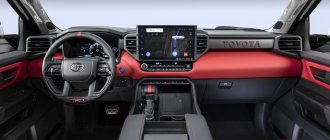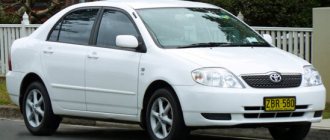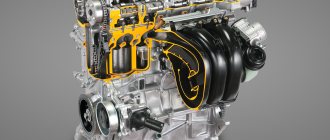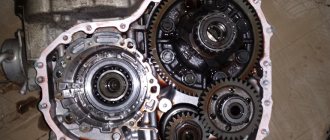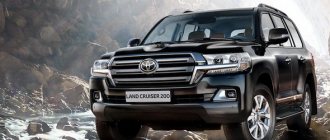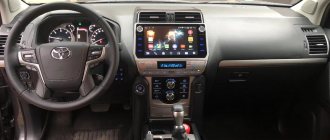Specifications
Power unit
The Japanese company has prepared the following technical specifications for the Toyota Tundra.
Under the hood there are 3 gasoline power plants that work with two transmission options. The initial versions will receive a V-shaped 6-cylinder naturally aspirated 4.0-liter engine, which has a distributed injection system. It develops 270 “horses” (376 Nm). The fuel consumption of a Toyota Tundra with such an engine ranges from 13.4 to 13.8 liters of gasoline for every 100 kilometers in mixed mode. For the intermediate version, the Japanese have provided a 4.6-liter 8-cylinder V-shaped power plant with a distributed power system that produces 310 horsepower (460 Nm). For those who are interested in the consumption of the Toyota Tundra with this “engine” - 14.7 liters of gasoline in the combined cycle.
For the most “sophisticated” version, a V-shaped 8-cylinder 5.7-liter power plant was prepared, which received a multi-point fuel supply system. It allows you to generate 381 horsepower (401 Nm). Fuel consumption of the Toyota Tundra 2020 was 15.7 liters per “hundred” in mixed mode, according to information from the manufacturer.
Transmission
For the initial “engine,” only a 5-speed automatic gearbox is provided, which transmits all power only to the rear wheels. The intermediate 4.6-liter and the most powerful 5.7-liter version work together with a 6-speed automatic transmission and rear-wheel drive or 4x4.
The all-wheel drive transmission on the 2nd generation Toyota Tundra 2020 was built according to the traditional Part-time structure, where the front part is connected after turning the washer, which is located on the central panel. Moreover, the technical characteristics of the Toyota Tundra made it possible to install a reduction gear on the car, and the rear axle has a limited slip differential with the Active Trac function, controlled by an electronic system.
Chassis
As the basis for the Japanese pickup truck, they decided to use a powerful spar-type frame, on which the engine is placed longitudinally, and the cabin and body are installed. The front part boasts an independent suspension with double wishbones, anti-roll bars and springs, while the rear has a dependent design with leaf springs and a spring suspension.
The machine is controlled using a rack and pinion steering mechanism, which is complemented by a built-in hydraulic booster. The braking system has powerful four-piston all-round disc calipers, which are complemented by ABS, EBD, and Brake Assist as standard.
Safety
The gigantic car has a large number of up-to-date assistants and systems, thanks to which it ensures passive and active safety of passengers. This may include:
- Anti-lock braking system;
- Front, side, and curtain airbags;
- Rear camera;
- A-TRAC traction control system;
- Stabilization system;
- Parking sensors;
- Technology that monitors lanes;
- Blind spot monitoring sensors;
- Traction-control;
- Technology that can distribute forces during braking;
- Tire pressure monitoring sensors;
- Immobilizer;
- Central locking with remote control;
- "Cruise";
- Front and rear headlights with LED filling;
- Fog lights, as well as LED running lights;
- LACTH child seat anchors;
- Seat belts and other things.
Engineers also worked on the body, making it more rigid. In its production, ultra-high strength steel grades are used. They didn’t forget to equip the new 2nd generation Toyota Tundra with a programmed crumple zone.
Technical part
For the 1st generation Japanese Toyota Tundra pickup truck, engineers decided to provide only naturally aspirated gasoline engines with a distributed gasoline supply system. The engine compartment of the car was equipped with V-shaped 6- and 8-cylinder engines with a displacement of 3.4 to 4.7 liters, which generated 190-282 horsepower (298-449 Nm).
For such power plants, the Japanese installed a 5- or 6-speed manual, or a 4- or 5-band automatic gearbox. There were modifications with rear-wheel drive, as well as part-time all-wheel drive with 3 operating modes.
As the base of the new product, they decided to use the original powerful spar frame, on which stood the body and a steel cargo platform. The front part received an independent torsion bar suspension suspended on double wishbones, but the rear part was equipped with a rigid axle with leaf springs on a subframe. The large pickup truck is steered using hydraulic power steering.
The braking system of the Toyota Tundra includes ventilated front discs and rear drums, as well as ABS. Today you can buy a car in Russia only on the secondary market. The price of a 1st generation Toyota Tundra starts at an average of 1,300,000 rubles.
Third generation
5-door Niva: owner reviews, description, technical characteristics, dimensions
At an exhibition in Chicago in 2013, a new Toyota Tundra with a choice of four engines was presented. Three variations of pickup cabs, three wheelbase options, a choice of one of two transmissions (automatic or manual) - the buyer could choose any model at his discretion. The Toyota Tundra looked simply beautiful in its new body.
The engine variations are:
- Engine 5.7 liters, eight cylinders, power 381 hp. s., torque 544 Nm.
- Volume 4.6 liters, eight cylinders, power 310 hp. s., torque 444 Nm.
- Volume 4.0 liters, six cylinders, power 236 hp. s., torque 361 Nm.
In 2015, Toyota again releases a new modified version of the Toyota Tundra TRD Pro. Looking at the photo of the first generation Toyota Tundra, you can see that the exterior of the car has changed a lot over the years of production. You can see new lines, an engine update. All these improvements have taken the Tundra to a completely new level.
The price of the car also broke records, and its sale starts at 5 million rubles. The total weight of the Toyota Tundra is more than four and a half tons. If you compare the Toyota Cruiser with the Tundra, the dimensions of the second significantly exceed the dimensions of the first:
- The length of the new pickup is 5545 mm.
- Cabin width - 1910 mm.
- The height of the car is 1796 mm.
- The pickup truck has all-wheel drive.
- Engine capacity - 5.7 l.
- Horsepower - 381.
- Torque - 543 Nm.
- Fuel - gasoline.
- Fuel tank - 100 l.
- Acceleration time to 100 km/h is 6 seconds.
- Maximum speed - 220 km/h
- Consumption city - 22 l.
- Highway consumption - 13.5 l.
- Mixed cycle - 16.5 l.
The body dimensions of the Toyota Tundra, as you might have noticed, have changed significantly since the release of the first car in the series.
Second generation, characteristics
The dimensions of the second generation Toyota Tundra have a significant difference with the first generation:
- The length of the machine is 5329 mm, depending on the configuration there are two more versions - 5809 mm and 6266 mm.
- The width of the car is 2030 mm.
- The height of the pickup is 1930 mm.
- Ground clearance - 265 mm.
- The wheelbase is presented in three versions - 3220 mm, the second - 3700 mm, and the third - 4180 mm.
- Car weight -2077 (2550) kg.
- Tank volume - 100 l.
In terms of safety, Toyota Tundra has no competitors. She scored almost all the highest scores in crash tests, showing excellent results.
Tuning
Toyota Tundra 2010
The stylish and unusual appearance of a pickup truck often gives inspiration to their owners for creative experiments. Tuning a Toyota Tundra car can be aimed at improving its technical characteristics and exterior.
The vehicle's carrying capacity according to the passport is 825 kg, in addition, it is possible to tow a trailer. To protect cargo from external influences, equipment manufacturers offer special glazed roofs.
One of the most famous companies engaged in the manufacture of accessories and components for tuning Toyota Tundra is Devolro. The company is located in Miami and has a specialized studio that creates real masterpieces from serial cars. From an ordinary pickup truck they make a car that is not inferior in comfort to a limousine while fully maintaining its characteristics.
The craftsmen from the Devolro studio approach the issue of tuning the Toyota Tundra creatively; even a fairly standard package of body kit and additional equipment looks unusual in their execution.
A winch covered with a steel casing, an additional headlight unit, and a modified suspension allow the car to feel great off-road. The catchy appearance makes the device stand out from the crowd on the roads.
A Toyota Tundra tuned in a specialized studio means not only changes in appearance. At the request of the client, the vehicle is equipped with a fuel tank of increased volume, which allows the cruising range to be increased to 1000 km without refueling. Installing an air suspension allows you to increase the load capacity by one and a half times and increase the stability of the vehicle on public roads.
Dimensions of Toyota Tundra, characteristics
Detailed review of the tomahawk tw-9020 car alarm: characteristics, installation, configuration and operating instructions, owner reviews
The first generation of the Tundra was produced in three different body styles:
- Two doors and one row of seats.
- Four doors and two rows of seats.
- Extended cab version.
The factory offered two Tundra engine options:
- 24 valves, 3.4 liters, six-cylinder engine (V6). Engine power - 190 horsepower. Torque - 298 Nm.
- 32 valves, 4.7 liters, eight-cylinder engine (V8). Engine power is 245 horsepower, torque is 428 Nm.
Based on the above body variations, there were different dimensions of the Toyota Tundra:
- The length of the car is 5525 mm.
- The length of the version with an extended cabin is 5845 mm.
- Width - 1910 mm, second option - 2014 mm and third - 2024 mm (depending on body type).
- The Tundra wheelbase is 3260 mm.
- The wheelbase of the extended cab version is 3569 mm.
- Transmission: five-speed manual and five-speed automatic.
The first generation included two modifications. The first generation Toyota Tundra was produced from 2000 to 2006. The first car model was released before the beginning of 2004. The second modification entered the assembly line in 2005.
After 2005, other engines began to be installed on the Tundra. The four-liter six-cylinder engine had a power of 236 “horses” and a torque of 361 Nm. The 4.7-liter engine was also updated; Toyota increased power to 271 horsepower by shifting the valve timing, and engine power was increased to 424 Nm. Transmissions were changed to six-speed (manual and automatic).
The extended cabin option looks like it gives rear-row passengers a full-fledged large door.
Toyota Tundra Body Dimensions
The maximum length of the Toyota Tundra body is 6266 (mm), the maximum width is 2029 (mm), the maximum height is 1935 (mm).
Possible body sizes for Toyota Tundra:
The Toyota Tundra is a full-size pickup truck with a single, crew cab, or crew cab, produced by Toyota Motor Corporation since 1999.
Taking into account restyling, the model is produced in two generations. The first has 20 modifications, the second - 32.
Parameters of the Toyota Tundra I 3.4 AT 4WD single cab pickup truck:
- Length: 5525 mm;
- Width: 1910 mm;
- Height: 1796 mm;
- Wheelbase: 3259 mm;
- Ground clearance: 274 mm.
Parameters of the Toyota Tundra II 5.7 AT pickup truck with a one-and-a-half cab:
- Length: 5809 mm;
- Width: 2029 mm;
- Height: 1930 mm;
- Wheelbase: 3700 mm;
- Ground clearance: 260 mm.
Parameters of the Toyota Tundra II 5.7 AT 4WD double cab pickup truck:
- Length: 6266 mm;
- Width: 2029 mm;
- Height: 1930 mm;
- Wheelbase: 4180 mm;
- Ground clearance: 260 mm.
Important: Wheelbase is the distance between the center points of the front and rear wheels.
Toyota Tundra has a long wheelbase - from 3259 to 4180 (mm).
Appearance
The car has aggressive shapes, which is what marketers most likely wanted to attract young buyers. This car will not remain on the road without attention until everyone gets used to it, and this will take a lot of time.
The muzzle received a high, slightly embossed hood with a wide air intake that directs air into the engine compartment. Large optics, unfortunately with halogen filling, are used here. Between the headlights there is a huge radiator grille, which adds aggression to the appearance. The truly massive bumper has large plastic protection and round fog lights.
The side of the model is distinguished by very swollen wheel arches and stampings that come from the front optics. A similar stamping is also present above the rear arch. You can also notice a small stamping in the lower part of the body. The car mirrors are simply huge and you can see everything in them.
From the rear, the car looks like a classic pickup truck - large optics, a regular trunk lid with a comfortable handle and a small stamping. The rear bumper is also made in the style of conventional pickups, a huge chrome bumper.
Of course, due to the fact that the designers changed the appearance of the car, the dimensions of the body also changed:
- length – 5814 mm;
- width – 2029 mm;
- height – 1930 mm;
- wheelbase – 3701 mm.
The manufacturer also offers a 2-door and 4-door Long version, which of course differ in size, but their appearance is approximately the same.
Engine
Toyota Tundra engine characteristics: the car is available in two variations of the power unit: gasoline and diesel. Using a 5.7-liter engine, 381 hp can be squeezed out of the engine.
This model range has an extensive range of engines of the following types:
- V6 (diesel): volume 4 liters, 270 hp, torque – 278 Nm;
- V8 (diesel): volume 4.6 liters, 310 hp, torque – 327 Nm;
- V8 (gasoline): volume 4.6 liters, 310 hp, torque – 327 Nm;
- V8 (gasoline): volume 5.7 liters, 381 hp, torque – 401 Nm.
Owners of even the weakest 4-liter engine will be able to overcome difficult roads. What can we say about the engines of the highest power, which can turn a car into a truly all-terrain vehicle.
I generation (1999-2006)
The Japanese presented their debut car in May 1999. Initially it was known as T150s, but Ford felt that this name was very similar to the name of the class leader Ford F-150. After a lawsuit, the Japanese company was forced to change the name of the car to Tundra. Already in 2003, the first generation of Toyota Tundra underwent restyling, which had a positive effect on the exterior and interior. In addition to this, the Toyota Tundra pickup truck received new power units.
Purpose
Until recently, pickup trucks were not in frequent demand. However, times are changing, and more and more people are growing who would like to buy a large pickup truck that would meet their requirements. Fortunately, the North American market can offer a car of this model range for any driver.
Some argue that a pickup truck is a “farm machine” or a “household machine.” And there is some truth in this. The cargo compartment is large in size, which makes it possible to transport large cargo in it, be it bags of vegetables or new upholstered furniture. What's the point of taking a large machine and not using it for its intended purpose?
Others say that a big car is just a way to satisfy their ego and show off. This opinion is also acceptable and dealers count on it. But who is stopping you from using the car in your own way at the same time: for example, going on vacation, taking with you the maximum necessary amount of things.
The Toyota Tundra is a fairly passable car, which means that another purpose is to travel to hard-to-reach places: be it a forest, a desert or a field. Not only can you go out of town for a weekend ride, but in the luggage compartment you can also take bicycles and fishing equipment with you. The advantages are obvious.
Comparison with competitors
It is not easy for the Japanese company in this class, since it has to constantly compete with more common car companies. Toyota Tundra's competitors include Chevrolet Silverado, Dodge RAM, Chevrolet Avalanche, Chevrolet Colorado, Mitsubishi L200, Nissan Navara, GMC Sierra, and Ford F-150. It is not difficult to guess why most of the above cars have American citizenship.
Americans are very fond of large and practical cars, so companies that have some experience in this regard take advantage of this by providing their “countrymen” with excellent pickup trucks. Because of this, it is not easy for the Japanese to compete with them, especially since they act as “foreigners” in America.
Controversial issues
We noted above that not everyone accepts the option of installing a unit from Cummins. Why? After all, Toyota manager Rick Lofaso actually said that Cummins engines are a good option. Lofaso emphasized that the use of diesel from this manufacturer will allow it to gain instant recognition, since Cummins is today a leader in diesel engine technology. In addition, Toyota has already collaborated with other companies, so there should not be any special difficulties.
Almost the same words were said by the company's national brand manager, Michael Kroll. But in the end it turned out that Toyota representatives only indicated that Cummins, due to its fame, would attract buyers.
However, no one from the company confirmed the information that the Toyota diesel pickup truck will still use Cummins engines. This is what led to the emergence of a different point of view.
According to her (point of view), the use of Cummins diesel engines for Toyota will be very doubtful, since the company owns a share of another diesel manufacturer - Hino. And if it is possible to use, in fact, your own units, then why resort to the services of third-party companies and spend extra money (and this will change the price of Toyota Tundra diesel)? Consequently, Toyota will not install Cummins engines.
Therefore, it is a very common opinion that the 2021 Toyota Tundra diesel will take the already proven Aussie 4.5 liter unit. This engine is known from the Land Cruiser.
As an additional argument in favor of this point of view, it is also indicated that Toyota has repeatedly emphasized its intention to use its own investments in the development of diesel engines to the maximum extent possible. In addition, this will allow you to already have an idea of what the fuel consumption of a Toyota Tundra diesel will be.
Thus, there is still no consensus regarding a specific diesel unit. What is clear is that the company firmly intends to release a diesel version. In addition, a lot of data is still unknown: how much does a Toyota Tundra cost with a diesel engine, what else will be new. Therefore, we will wait, and now we invite you to watch a test drive of a Toyota Tundra on gas fuel!
Salon
Although the Toyota Tundra is intended for utilitarian use, the interior is in no way behind those of more expensive cars. The multifunctional steering wheel, like the car itself, is quite impressive in size.
The front panel houses several analogue clocks and an LCD navigation display. In the center is a large display of a multimedia player. Just below are climate control and buttons for switching auxiliary functions.
Opposite the front passenger seat you can find a spacious glove compartment, which includes a cooling option. High-quality materials are used when assembling the interior.
The chairs are also large. They have an adjustment function, both separately for the back and the headrest. The armrests provided to support the arm are located very well and effectively cope with their task.
A second row of seats is not provided for all models, but if it is available, it can comfortably accommodate up to three people. There are spacious storage compartments under the seat cushions that provide additional useful space for carrying personal items.
Interior
Despite its utilitarian purpose, the interior of the updated 2nd generation Toyota Tundra is in no way inferior to more expensive and presentable SUVs. On the driver's seat you can see a massive four-spoke multifunction steering wheel, as well as an improved instrument panel, represented by several analogue dials and an LCD monitor of the trip computer.
The massive center console has a large 8-inch entertainment system display, a laconic climate control unit, as well as auxiliary mechanical switch buttons. It is important to understand that the base trims of the 2021 Toyota Tundra have more archaic equipment. Opposite the passenger sitting in front, there was room for a spacious glove compartment, which received a cooling function as a separate option.
If we talk about the quality of finishing materials, as well as the entire assembly as a whole, it is at a good level. There is a large, comfortable armrest between the front seats. For those sitting in front, there are impressive armchairs that have clearly felt lateral support, a large number of different adjustments and additional functions. And on the second row (if there is one) you can accommodate three passengers.
The Crew Max modification boasts a more spacious interior than the Double Cab version, where there is a lack of space. It is important to note that under the seat cushions there are special compartments where you can put various tools and more. Inside you can see genuine leather, wood and metal-look inserts.
There is no luggage compartment as such, so there is no point in talking about its volume. The length of the onboard platform is 1,680-2,470 millimeters, and the width and depth are 1,690 millimeters and 500 millimeters, respectively. As for the cargo area itself, it can take on board from 725 to 950 kilograms, depending on which modification.
Exterior Features
Perhaps the first thing you notice when looking at the updated Toyota Tundra 2021 pickup truck is the design of the front of the car. The huge radiator grille, which climbs far onto the hood and occupies the main part of the bumper, dazzlingly shines with chrome.
The head optics look no less expressive. Having a slight slope towards the central part of the bumper and beveled lower outer edges, the headlights, as if coming out of the radiator grille, give the appearance of an impressive pickup truck a very severe look.
At the bottom of the two-piece front bumper there are fog lamps of a classic round shape and powerful metal protection that reliably protects the car from damage when driving off-road.
The massive hood and sculpted front fenders give the pickup extra brutality. The horizontal stampings at the bottom of the doors, almost above the step steps, also look harmonious.
In profile, the Toyota Tundra looks like a typical American pickup truck - massive and slightly rough. But such rudeness is, rather, a consequence of the huge dimensions of the car, and not any omission of Japanese designers. Large chrome door handle brackets, large wheel arches in which chrome rims gleam - all this is clearly designed for the American buyer with a classic vision of the design of a large pickup truck.
It should be noted that the developers of the model did not spare chrome on the exterior of the car - the rear bumper shines brightly in the sun, the huge “mugs” of the exterior mirror housings, as well as the chrome emblems attached to the front doors of the car.
However, you should not underestimate the car, considering it just a bright toy for residents of the American outback. The wheel arches of a pickup truck can easily accommodate wheels shod with toothy off-road tires, and the ground clearance, reaching 230 mm, indicates the very serious potential of the car not only off paved highways, but also off dirt roads. The cargo compartment of the car is also very roomy, looking quite modest from the outside.
As in previous versions of the model, the car is offered in three cab versions: “Regular Cab” (basic version with a single cabin), “Double Cab” (classic double cabin) and the most spacious and comfortable version “CrewMax”. Any version is available with rear-wheel drive or all-wheel drive. In addition, speaking about the car’s configurations, it is worth noting that the “1794 Edition” and “Platinum” options were added to the basic versions (SR, SR5, Limited) as a result of restyling. It is noteworthy that the first of these versions received its name in honor of the ranch, which was once located in San Antonio and on the site of which there is currently a plant producing Toyota Tundra pickups.
The overall dimensions of the car have remained virtually unchanged: the length of the car is 5,809 mm, its width is 2,029 mm, and its height does not exceed 1,935 mm. But the engineers seriously worked on aerodynamics, significantly reducing the level of resistance to oncoming air flows, which not only affected the reduction in fuel consumption, but also had a positive effect on the stability of the vehicle.
Toyota Tundra dimensions
The dimensions of the car are gigantic and brutal, all parameters are in the table:
| Parameter | Meaning |
| Length | 5791mm |
| Width | 2006mm |
| Height | 1930mm |
| Wheel base | 3683mm |
| Clearance | 265mm |
Dimensions table The cargo compartment also has impressive dimensions: 1,961 m long and 1,676 m wide. The ground clearance, in the size table, is 265mm, which makes the car incredibly stable and passable even off-road.
Three car form factors are available to buyers:
- short wheelbase, regular cab;
- the base is long, the cabin is double, slightly extended;
- the base is long, a full-fledged double cabin.
Fans of large vehicles will have no problem choosing an iron friend “to their liking” among this model range, based on their preferences.
Many people wonder how much the Toyota Tundra weighs with such dimensions. Toyota Tundra has a weight ranging from 1721 kg to 2661 kg, depending on the configuration. When choosing a car, you need to take into account that the larger the car, the more difficult it is to drive. However, in terms of safety, large vehicles are unrivaled.
2018 Toyota Tundra prices and options
the car's configuration will include
- Multimedia center with 6.1” monitor;
- Integrated rear view camera;
- Front and side aibags in the amount of 4 pcs;
- Pre-Collision System;
- Cruise control;
- LATCH fastening mechanisms;
- TRMS and TSC systems;
- Anti-lock braking system;
- Electronic immobilizer;
- Halogen optics and LED daytime running lights;
- Air conditioner;
- Power windows on all doors;
- Electrically adjustable exterior mirrors;
- Steel wheels R18;
- Seat belts;
- Multi-steering wheel;
- Central locking;
- Integrated Trailer Brake Controlle and more.
The advanced Platinum package will cost the buyer at least 47.38 thousand dollars and will additionally offer:
- Alloy wheels R20;
- LED optics “in a circle”;
- Advanced acoustics from JBL;
- Multimedia-;
- Leather interior trim;
- Rear Cross-Traffic Alert system;
- Dual zone climate;
- Auto-dimming interior mirror;
- Decorative inserts on the front dashboard;
- Adaptive cruise control system;
- Sensors for monitoring “dead” zones;
- 8 airbags and much more.
Options and prices
In total, 6 trim levels are offered for the full-size Japanese pickup truck:
- SR;
- SR5;
- Limited;
- Platinum;
- 1794 Edition;
- TRD Pro.
The most basic configuration of the Toyota Tundra 2 on the North American market will cost at least $31,420. The most expensive and “sophisticated” version is priced at $49,650 . The difference in price is huge, but the basic version already boasts:
- 1-inch multimedia center;
- Built-in rear camera;
- Four front and side airbags;
- Pre-Collision System;
- "Cruise";
- LATCH fastening mechanisms;
- TPMS and TSC systems;
- Anti-lock braking system;
- Electronic immobilizer;
- Optics with halogen filling and LED DRL;
- Air conditioning;
- Electric windows on all doors;
- Electrically adjustable side mirrors;
- 18-inch steel “rollers”;
- Seat belts;
- Multifunctional “steering wheel”;
- Central locking;
- Built-in Trailer Brake Controlle and more.
Purpose
Until recently, pickup trucks were not in frequent demand. However, times are changing, and more and more people are growing who would like to buy a large pickup truck that would meet their requirements. Fortunately, the North American market can offer a car of this model range for any driver.
Some argue that a pickup truck is a “farm machine” or a “household machine.” And there is some truth in this. The cargo compartment is large in size, which makes it possible to transport large cargo in it, be it bags of vegetables or new upholstered furniture. What's the point of taking a large machine and not using it for its intended purpose?
Others say that a big car is just a way to satisfy their ego and show off. This opinion is also acceptable and dealers count on it. But who is stopping you from using the car in your own way at the same time: for example, going on vacation, taking with you the maximum necessary amount of things.
The Toyota Tundra is a fairly passable car, which means that another purpose is to travel to hard-to-reach places: be it a forest, a desert or a field. Not only can you go out of town for a weekend ride, but in the luggage compartment you can also take bicycles and fishing equipment with you. The advantages are obvious.
Car history
Since the first release of the new car in 1999, the model has managed to fall in love with many car enthusiasts, and has also received various diplomas for quality, reliability and cost. It is important to note that the production of the Toyota Tundra was intended largely for the American market, and this was a rather bold and daring decision on the part of the Japanese company: many understand that there are plenty of pickup trucks on the American market. But despite this, Toyota was able to combine the best features of Japanese and American vehicles in its car.
Engine
Toyota Tundra engine characteristics: the car is available in two variations of the power unit: gasoline and diesel. Using a 5.7-liter engine, 381 hp can be squeezed out of the engine.
This model range has an extensive range of engines of the following types:
- V6 (diesel): volume 4 liters, 270 hp, torque – 278 Nm;
- V8 (diesel): volume 4.6 liters, 310 hp, torque – 327 Nm;
- V8 (gasoline): volume 4.6 liters, 310 hp, torque – 327 Nm;
- V8 (gasoline): volume 5.7 liters, 381 hp, torque – 401 Nm.
Owners of even the weakest 4-liter engine will be able to overcome difficult roads. What can we say about the engines of the highest power, which can turn a car into a truly all-terrain vehicle.
Let's sum it up
What can we say at the end? The updated Toyota Tundra 2020 is a modern pickup truck that has received an aggressive appearance, a spacious interior, as well as a rich list of equipment and high-torque power units that allow you to feel confident on any road surface.
Although some may believe that the Japanese have no place in the American market due to the fact that American models are already “ruling” there, this is not so. The new product can quite successfully compete with the legendary Ford F-150, which is very popular in various markets around the world. It is clear that the Japanese do not give up so easily, trying to fully compete for the American market in this class.
Considering all the advantages of the new product, which include a solid, aggressive exterior, a pleasant, modern interior, high ground clearance, all-wheel drive, excellent cross-country ability and powerful engines, it will be able to alert leading American manufacturers.
We advise you to read the article: History of Toyota: from looms to cars
Appearance
The dimensions are gigantic and the interior is up to par, but the Toyota Tundra still has something to show off to drivers. Huge headlights with LED filling will help you see even the smallest details in the dark. The large false radiator grille is divided by three lamellas arranged horizontally; in the center is the Toyota logo.
An additional air intake is placed on top of the radiator grille. Fog lights are located on the powerful bumper.
When examining the car in profile, you can see that the wheel arches have an unusual, almost square shape. The wheel radius is usually 18, but in tuned versions of cars you can also find a 22 radius.
At the rear of the car there are large side lights, a tailgate with the Tundra designation and a massive bumper. The body has many colors and there is plenty to choose from. The model range is presented in 10 colors: white, silver, wet asphalt, black, black pearl, red, burgundy, bronze, blue and brown.


